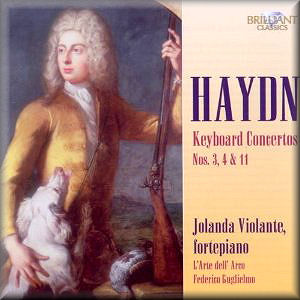 |
 |
|


alternatively
CD: MDT
AmazonUK
AmazonUS
|
Franz Joseph HAYDN (1732-1809)
Keyboard concerto in D major, H XVIII:11 [19:44]
Keyboard concerto in G major, H XVIII:4 [23:55]
Keyboard concerto in F major, H XVIII:3 [21:00]
 Jolanda Violante (fortepiano)
Jolanda Violante (fortepiano)
L’Arte dell’Arco/Federico Guglielmo (violin and director)
rec. 18-28 April 2008, Studio Magister, Preganziol-Treviso, Italy.
 BRILLIANT CLASSICS 94175 [64:22]
BRILLIANT CLASSICS 94175 [64:22] 
|
|
|
Nothing contrasts Haydn’s music with that of his contemporary
and friend Mozart like their keyboard concertos. Haydn wrote
some 14 concertos to Mozart’s 27, and many of these were as
capable of being played on the organ or harpsichord as on the
fortepiano. Admittedly the early Mozart concertos also lend
themselves to the harpsichord – I have a recording of no. 9,
the “Jeunehomme”, on that instrument. But Mozart’s mature concertos
are inseparable from the dynamic contrasts of the fortepiano.
He, far more than Haydn, grasped the potential for dramatic
and intimate dialogue between soloist and orchestra. The result
is that, while Mozart’s concertos are central to his evolution
as a composer, the same cannot be said of those by Haydn.
The Haydn keyboard concertos are nevertheless worth getting
to know. The two earliest examples on this recording date from
1770-71, and are pleasant works in the Galant style. The last,
no. 11 in D major, has been dated to 1779-80, and is much more
in the style of the Classical concerto. For most people this
work is “The Haydn keyboard concerto”; it has received far more
recordings than any other of Haydn’s keyboard concertos. On
the present disc these concertos are all played on a fortepiano
by Jolanda Violante, with a period instruments orchestra.
There are no notes about the instrument Violante is playing,
but it sounds like a modern copy of a fortepiano. Unfortunately
the sound of this instrument is the major letdown of this disc.
It is just not very interesting, having little of the contrasting
registers and tonal variety of historic fortepianos like a Stein
or Graf. I don’t know if it has an una corda pedal, but
if so I couldn’t hear any trace of it; this effect would have
added some much needed variety to its tone colour.
Violante does not add much ornamentation, or employ rubato noticeably,
except in the slow movements. Her playing of these works is
generally very enjoyable; her passage work is clean and her
demeanour is both sprightly and imperturbable. Occasionally,
for example in the “Hungarian” finale of no. 11, she races the
orchestra in a vivacious fashion. The light action of the fortepiano
comes into its own in the outer movements, allowing Violante
to rattle off the extended scale and arpeggio passages at great
velocity. But the slow movements are a little on the dull side,
mainly because of the rather dead-sounding solo instrument.
The orchestra has an attractively “coloured” sound and plays
in excellent style, with the usual period instrument dynamic
bulges. The finales are attacked with real brio and vitality.
No information is given about this ensemble, but they sound
quite small in number. Winds feature only in no. 11; the liner-notes
mention that no. 3 includes a pair of ad libitum horn
parts, but only strings are used for this and no. 4. For some
reason the orchestra sounds a bit livelier (and louder) in concertos
nos. 3 and 4 than in no. 11. This is a pity, because it means
that, although no. 11 is the most substantial work on this disc,
it gets the most distant recording.
Leif Ove Andsnes recorded the same three Haydn concertos in
2000 with the Norwegian Chamber Orchestra. That recording received
Gramophone magazine’s award for "Best Concerto Recording"
for that year. On that disc (EMI Classics 56960), the concertos
are played in ascending number order; for some reason, the Brilliant
disc plays them in the reverse order. Andsnes directs the orchestra
as well as playing the solo on a modern grand piano, and does
both with his usual sensitivity. Tempos are similar to those
on the Brilliant disc. Although the orchestra plays on modern
instruments, it adopts several period-instrument practices.
These performances thus have most of the advantages of a historically
informed performance, with none of the drawbacks. The Concerto
no. 11 is also available in the same recording on the compilation
disc set “Leif Ove Andsnes: a portrait” (EMI Classics 74789).
Those who dislike the fortepiano won’t be converted by this
release. However its bargain price, together with Jolanda Violante’s
stylish playing and a really excellent period orchestra are
undoubted attractions.
Guy Aron
|
|

